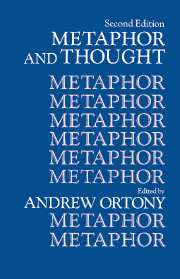Book contents
- Frontmatter
- Contents
- List of contributors
- Preface to the second edition
- Preface to the first edition
- 1 Metaphor, language, and thought
- METAPHOR AND MEANING
- 2 More about metaphor
- 3 Figurative speech and linguistics
- 4 The semantics of metaphor
- 5 Some problems with the notion of literal meanings
- 6 Metaphor
- 7 Language, concepts, and worlds: Three domains of metaphor
- 8 Observations on the pragmatics of metaphor
- METAPHOR AND REPRESENTATION
- METAPHOR AND UNDERSTANDING
- METAPHOR AND SCIENCE
- METAPHOR AND EDUCATION
- References
- Author index
- Subject index
7 - Language, concepts, and worlds: Three domains of metaphor
Published online by Cambridge University Press: 05 June 2012
- Frontmatter
- Contents
- List of contributors
- Preface to the second edition
- Preface to the first edition
- 1 Metaphor, language, and thought
- METAPHOR AND MEANING
- 2 More about metaphor
- 3 Figurative speech and linguistics
- 4 The semantics of metaphor
- 5 Some problems with the notion of literal meanings
- 6 Metaphor
- 7 Language, concepts, and worlds: Three domains of metaphor
- 8 Observations on the pragmatics of metaphor
- METAPHOR AND REPRESENTATION
- METAPHOR AND UNDERSTANDING
- METAPHOR AND SCIENCE
- METAPHOR AND EDUCATION
- References
- Author index
- Subject index
Summary
According to Searle (this volume), metaphors represent a class of linguistic expression that says one thing and means another. In this respect, he points out, they resemble cases of irony and indirect speech acts. A characteristic of all such types of linguistic expressions is that the literal utterance – what in fact is said – is in some sense “defective,” taking the form of “obvious falsehood, semantic nonsense, violation of the rules of speech acts, or violations of conversational principles of communication.” The problem posed by such expressions is therefore to determine where, if not in the utterance itself, one should look to ascertain what they in fact mean. In this connection, Searle has introduced the distinction between (literal) sentence meaning and (speaker's) utterance meaning, and he has suggested that one should look to the latter for true meaning. In other words, the sentence may say one thing, but the speaker may intend (by it) something else, and the meaning to be inferred from the sentence must be attributed to and read off that intention. In saying, for example, “Sally is a block of ice,” the speaker may intend to convey that Sally is a cold and unresponsive person, and the hearer, to properly interpret that utterance, must read off that intended meaning.
There is much in Searle's account that is extremely beneficial to the study of metaphor, and if I differ from his views it is not so much that I disagree with his conclusions as that I envisage in my approach a different role to be played by metaphor.
- Type
- Chapter
- Information
- Metaphor and Thought , pp. 112 - 123Publisher: Cambridge University PressPrint publication year: 1993
- 10
- Cited by



